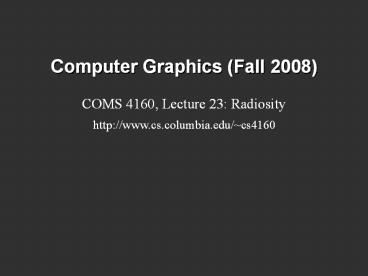Computer%20Graphics%20(Fall%202008) - PowerPoint PPT Presentation
Title:
Computer%20Graphics%20(Fall%202008)
Description:
The front faces are all diffuse white. The color is because of reflection ... If curious, read the rest of 16.3 and parts of Cohen and Wallace. Rendering Equation ... – PowerPoint PPT presentation
Number of Views:25
Avg rating:3.0/5.0
Title: Computer%20Graphics%20(Fall%202008)
1
Computer Graphics (Fall 2008)
- COMS 4160, Lecture 23 Radiosity
http//www.cs.columbia.edu/cs4160
2
Radiosity
- Cornell box with color bleeding Goral et al 84
3
Photograph of a sculpture. The front faces are
all diffuse white The color is because of
reflection from rear-facing colored faces
Raytracing makes all faces white. It can handle
specular reflection and shadows, but not
diffuse-diffuse interreflection or color bleeding
Radiosity correctly captures the color bleeding
from the back of the boards to the front.
4
Advantages and Disadvantages
- Radiosity methods track rate at which energy
(radiosity) leaves diffuse surfaces - Determine equilibrium of light energy in a
view-independent way - Allows for diffuse interreflection, color
bleeding, and walkthroughs - Difficult to handle specular objects, mirrors
5
General Approach
- Assume diffuse surfaces discretized into a finite
set of patches or finite elements - Radiosity equation is a matrix equation or set of
simultaneous linear equations derived by
approximations to the rendering equation - Solve iteratively using numerical methods
6
Earliest Radiosity pictures
- Radiosity was first developed in other fields
- Heat transport, Lighting Design
- In graphics
- Goral et al. 84
Parry Moon and Domina Spencer (MIT), Lighting
Design, 1948
7
Outline
- Rendering equation review
- Radiosity equation
- Form factors
- Methods to compute form factors
High-level overview only. Best textual reference
is probably Sections 16.3.1 and 16.3.2 in FvDFH.
This will be handed out. If curious, read the
rest of 16.3 and parts of Cohen and Wallace.
8
Rendering Equation
Surfaces (interreflection)
Cosine of Incident angle
Reflected Light (Output Image)
Emission
BRDF
Reflected Light
UNKNOWN
KNOWN
KNOWN
UNKNOWN
KNOWN
9
Change of Variables
- Integral over angles sometimes insufficient.
Write integral in terms of surface radiance only
(change of variables)
10
Change of Variables
- Integral over angles sometimes insufficient.
Write integral in terms of surface radiance only
(change of variables)
11
Rendering Equation Standard Form
- Integral over angles sometimes insufficient.
Write integral in terms of surface radiance only
(change of variables) - Domain integral awkward. Introduce binary
visibility fn V
Same as equation 2.52 Cohen Wallace. It swaps
primed And unprimed, omits angular args of BRDF,
- sign. Same as equation above 19.3 in Shirley,
except he has no emission, slightly diff.
notation
12
Radiosity Equation
Drop angular dependence (diffuse Lambertian
surfaces)
Change variables to radiosity (B) and albedo (?)
Expresses conservation of light energy at all
points in space
Same as equation 2.54 in Cohen Wallace handout
(read sec 2.6.3) Ignore factors of p which can be
absorbed.
13
Outline
- Rendering equation review
- Radiosity equation
- Form factors
- Methods to compute form factors
Section 16.3.1,2 (eqs 16.63-65) in FvDFH
14
Discretization and Form Factors
F is the form factor. It is dimensionless and is
the fraction of energy leaving the entirety of
patch j (multiply by area of j to get total
energy) that arrives anywhere in the entirety of
patch i (divide by area of i to get energy per
unit area or radiosity).
15
Form Factors
16
Matrix Equation
17
Outline
- Rendering equation review
- Radiosity equation
- Form factors
- Methods to compute form factors
Section 16.3.2 in FvDFH
18
Nusselts Analog
Analytically project into hemisphere above point.
Then project onto hemisphere base Form factor
is ratio of area on base to area of entire base
This computes differential point to patch form
factor
Why does it work?
19
Hemicube
20
Hemicubes
- Each small hemicube cell has a precomputed delta
form factor add up to get final value - We can render the scene using normal Z-buffer
scan conversion onto the faces of the hemicube!
21
Monte Carlo Ray Tracing
- Can be used to find form factors (slow)
- Can be used directly to shoot energy
22
(No Transcript)































